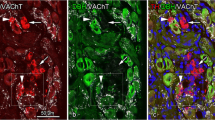Abstract
The development of chicken ultimobranchial glands was studied by electron microscopy. As early as at 8 days of incubation, some cells contained a few secretory granules, although most of the ultimobranchial cells were undifferentiated. Single axons or small bundles of axons were occasionally detected in close contact with the ultimobranchial cells. Subsequently, immature C cells gradually increased in number with age. At 12 days of incubation, the developing C cells, which contained some secretory granules from 60 to 200 nm in diameter, occupied the greater part of the gland. The cells were oval, elongated or irregular in shape and frequently gave rise to long cytoplasmic processes that touched other C cells. Numerous axons enveloped with Schwann cell processes occurred in close vicinity to C cells. At 14 days of incubation, the cytoplasmic processes of C cells reached their maximum number and size. Desmosome-like membrane specialization was observed at the contact between the processes and cell bodies of other C cells, while numerous microtubules were arranged in parallel to the long axes of the processes, and secretory granules were distributed along them. Thus, the C cells at these stages seem to regulate other homologous cells by direct contact. Axon terminals, which contained small, clear and large, densecored vesicles, were first found in direct contact with the surface of C cells in 14-day-old embryos. Subsequently, the cytoplasmic processes of C cells progressively decreased, while nerve fibers continued to increase in the ultimobranchial glands. At the late stages of embryonic development, many C cells displayed an oval outline and increased number and size of secretory granules. At hatching, many C cells were filled with large secretory granules ranging from 200 to 700 nm in diameter (average 300 nm). Some cells were still elongated or irregular in shape and contained small secretory granules, 60–200 nm in diameter.
Similar content being viewed by others
References
Aluments J, Ekelund M, El Munshid HA, Hakanson R, Lorén I, Sundler F (1979) Topography of somatostatin cells in the stomach of the rat: possible functional significance. Cell Tissue Res 202:177–188
Chan AS, Conen PE (1971) Ultrastructural observations on cytodifferentiation of parafollicular cells in the human fetal thyroid. Lab Invest 25:249–259
Coleman R, Phillips AD (1974) The development and fine structure of the ultimobranchial glands in larval Rana temporaria L. Cell Tissue Res 148:69–82
Isler H (1973) Fine structure of the ultimobranchial body of the chick. Anat Rec 177:441–460
Ito M, Kameda Y, Tagawa T (1986) An ultrastructural study of the cysts in chicken ultimobranchial glands with special reference to C-cells. Cell Tissue Res 246:39–44
Jordan RK, Mcfarlane B, Scothorne RJ (1973) An electron microscopic study of the histogenesis of the ultimobranchial body and of the C-cell system in the sheep. J Anat 114:115–136
Kameda Y (1973) Electron microscopic studies on the parafollicular cells and parafollicular cell complexes in the dog. Arch Hist Jpn 36:89–105
Kameda Y (1989) Occurrence of calcitonin-positive C cells within the distal vagal ganglion and the recurrent laryngeal nerve of the chicken. Anat Rec 224:43–54
Kameda Y (1991) Immunocytochemical localization and development of multiple kinds of neuropeptides and neuroendocrine proteins in the chick ultimobranchial gland. J Comp Neurol 304:373–386
Kameda Y, Okamoto K, Ito M, Tagawa T (1988) Innervation of the C cells of chicken ultimobranchial glands studied by immunohistochemistry, fluorescence microscopy, and electron microscopy. Am J Anat 182:353–368
Kameda Y, Kameya T, Frankfurter A (1993a) Immunohistochemical localization of a neuron-specific β-tubulin isotype in the developing chicken ultimobranchial glands. Brain Res (in press)
Kameda Y, Hirota C, Murakami M (1993b) Imrnuno-electronmicroscopic localization of enkephalin in the secretory granules of C cells in the chicken ultimobranchial glands. Cell Tissue Res (in press)
Larsson LI, Goltermann N, De Magistris L, Rehfeld JF, Schwartz TW (1979) Somatostatin cell processes as pathways for paracrine secretion. Science 205:1393–1395
Pfenninger KH, Bunge RP (1974) Freeze-fracturing of nerve growth cones and young fibers. A study of developing plasma membrane. J Cell Biol 63:180–196
Robertson DR (1967) The ultimobranchial body in Rana pipiens. III. Sympathetic innervation of the secretory parenchyma. Z Zellforsch Mikrosk Anat 78:328–340
Stoeckel ME, Porte A (1969) Etude ultrastructurale des corps ultimobranchiaux du poulet I. Aspect normal et développement embryonnaire. Z Zellforsch Mikrosk Anat 94:495–512
Stoeckel ME, Porte A (1970) Origine embryonnaire et différenciation sécrétoire des cellules à calcitonine (cellules C) dans la thyroide foetale du rat. Z Zellforsch Mikrosk Anat 106:251–268
Author information
Authors and Affiliations
Rights and permissions
About this article
Cite this article
Kameda, Y. Electron microscopic study on the development of the chicken ultimobranchial glands, with special reference to innervation of C cells. Anat Embryol 188, 561–570 (1993). https://doi.org/10.1007/BF00187011
Accepted:
Issue Date:
DOI: https://doi.org/10.1007/BF00187011




